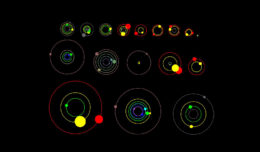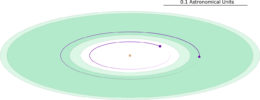In every batch of detections from the Kepler spacecraft, some transit signals get relegated to “false positive” status by an automated vetting pipeline. How do we ensure that real exoplanet detections don’t accidentally get discarded by the pipeline?
The Kepler False Positive Working Group is on the case — and they just rescued quite a find from being relegated to a false-positive fate.
To Be a Planet Candidate

An illustration of some of the planetary systems discovered by the Kepler spacecraft. The stars at the centers of these systems are not pictured. [NASA Ames/UC Santa Cruz]
The first hint in Kepler data of a potential transiting planet is what’s known as a “Threshold Crossing Event” (TCE). That TCE could either be a true signal from a planet transiting across the face of its host star, or it could be a false positive or false alarm — a signal mimicking a transiting planet that’s instead caused by a background eclipsing binary system, noise in the data, instrumental artifacts, etc.
Early on in the Kepler mission, every TCE was reviewed by a team of scientists and classified as a true planet candidate or a false positive. But as the mission ramped up and data volume grew, scientists turned to an automated pipeline — aptly named the Robovetter — to categorize the TCEs.

The transit signals of Kepler-1649 b (top; previously known) and c (bottom; newly discovered), in the star’s light curve. [Adapted from Vanderburg et al. 2020]
Human vs. Machine
The automated approach has many advantages: we can process larger volumes of data, and the statistical uniformity allows us to make inferences about the sample completeness. But it’s inevitable that the Robovetter will sometimes be wrong, misclassifying a true planet as a false positive.
To address this, the Kepler False Positive Working Group was established to visually inspect all signals the Robovetter classified as false positives and confirm the categorization. This process allows us to improve the Robovetter’s algorithms — and it also opens the door to new discoveries hidden in old data.
Such is the case with Kepler-1649c, a planet candidate that was incorrectly categorized by the Robovetter as a false positive. In a new study led by Andrew Vanderburg (NASA Sagan Fellow at The University of Texas at Austin), a team of scientists presents their rescue of this sneaky planet.
Earth-like Discovery

The locations of Kepler-1649 planets b and c relative to the star’s optimistic (light green) and conservative (dark green) habitable zone. [Vanderburg et al. 2020]
How did the Robovetter miss this important habitable-zone, Earth-like planet? Vanderburg and collaborators suspect that the pipeline was fooled into mistaking Kepler-1649’s location due to the star’s high proper motion. This introduced noise into the inferred light curve, making the Robovetter think the transit signal wasn’t real.
Vanderburg and collaborators point out that there are likely hundreds of undiscovered planets left in the extended Kepler mission data. While automated pipelines do a great job of doing the heavy lifting, the discovery of Kepler-1649c goes to show that there’s value in having a human eye checking results.
Citation
“A Habitable-zone Earth-sized Planet Rescued from False Positive Status,” Andrew Vanderburg et al 2020 ApJL 893 L27. doi:10.3847/2041-8213/ab84e5

3 Comments
Pingback: Rescuing an Overlooked Planet – Digital VanLife Magazine
Pingback: Rescuing an Overlooked Planet » What's Goon
Pingback: Rescuing an Overlooked Planet - Sky & Telescope - Worldika - New Platform For Explore World